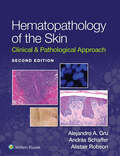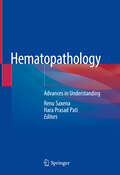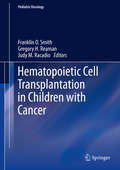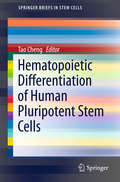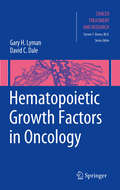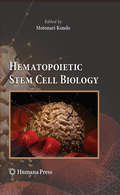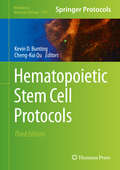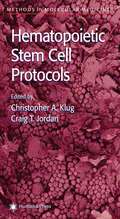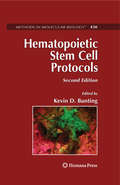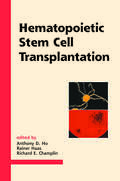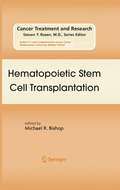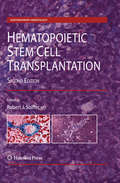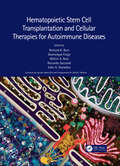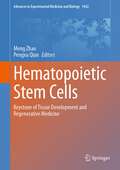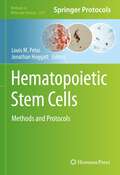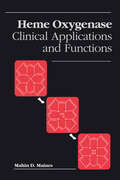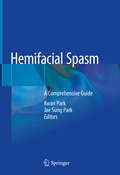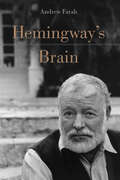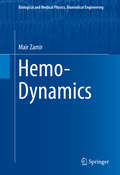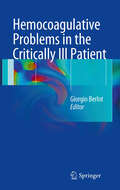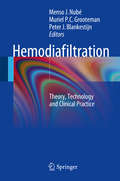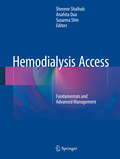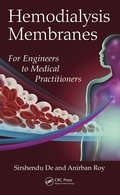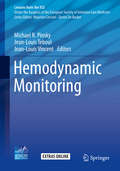- Table View
- List View
Hematopathology of the Skin: Clinical & Pathological Approach
by Alejandro A. Gru Andras Schaffer Alistair RobsonThe most comprehensive reference book on diagnosing cutaneous hematologic disorders available, Hematopathology of the Skin: Clinical and Pathological Approach, 2nd Edition, provides interdisciplinary guidance from more than 40 global experts in the fields of dermatopathology, dermatology, hematopathology, and hemato/oncology. Edited by Dr. Alejandro A. Gru, Dr. András Schaffer, and Dr. Alistair Robson, this concise yet comprehensive reference features a logical, consistent format heavily illustrated with high-quality clinical and pathological images throughout. Unparalleled in scope, it is a well-written, easy-to-follow resource for clinicians who care for patients with cutaneous hematologic neoplasms.
Hematopathology: Advances in Understanding
by Renu Saxena Hara Prasad PatiThis book covers recent advances in the understanding and management of essential hematological pathologies. In addition to updates on Hodgkin’s lymphoma, acute myeloid leukemia and other disorders, it provides essential information on transplant pathology, and the molecular and genetic aspects of hematological disorders. Offering a practical approach to lymphoma diagnosis, the book will help hematologists and pathologists alike make accurate diagnoses in keeping with the latest classifications and methodologies. A wealth of photographs and algorithms help readers understand the laboratory approach to the diagnosis of hematological disorders, reflecting the latest advances in the field. The book offers a valuable resource for residents of MD pathology, DM hematopathology and clinical hematology, as well as practitioners of hematology.
Hematopoietic Cell Transplantation in Children with Cancer
by Gregory H. Reaman Franklin O. Smith Judy M. RacadioThis book is a comprehensive and up-to-date compendium on all aspects of blood and marrow transplantation in children. After an introductory chapter describing the history of pediatric blood and marrow transplantation, subsequent chapters discuss pediatric-specific aspects of transplantation, including stem cell sources suitable for transplantation, preparative regimens, graft-versus-host disease, complications related to transplantation, and late effects. The role of blood and marrow transplantation in various specific pediatric diseases is then examined, and the closing chapter considers future directions. The authors are all internationally recognized experts and offer a largely evidence-based consensus on etiology, biology, and treatment. This handbook has far-reaching applicability to the clinical diagnosis and management of pediatric diseases that are treatable with blood and marrow transplantation and will prove invaluable to specialists, generalists, and trainees alike.
Hematopoietic Differentiation of Human Pluripotent Stem Cells
by Tao ChengThis book features the most cutting-edge work from the world's leading laboratories in this field and provides practical methods for differentiating pluripotent stem cells into hematopoietic lineages in the blood system. Pluripotent stem cells have attracted major interest from a fast-growing and multidisciplinary community of researchers who are developing new techniques for the derivation and differentiation of these cells into specific cell lineages. These direct differentiation methods hold great promise for the translational applications of these cells. This book is an essential reference work for researchers at all levels in the fields of hematology and stem cell biology, as well as clinical practitioners in regenerative medicine.
Hematopoietic Growth Factors in Oncology
by Gary Lyman David C. DaleProgress in the treatment of cancer over the past two decades has been rapid with many new and novel therapeutic modalities arriving at an unprecedented pace. Overall cancer mortality rates have actually begun to fall in parallel with progress in the diagnosis and treatment of malignant disease. Despite our advances in the understanding of the biology and molecular genetics of cancer, as well as the availability of an increasing array of effective therapies, cancer treatment today and for the foreseeable future will include the traditional modalities of surgery, radiation therapy and chemotherapy. Myelosuppressive agents with their potential hematopoietic toxicities remain the mainstay of systemic treatment for both metastatic and early stage cancer. The complications of cancer chemotherapy have serious impact on a patient's well being and overall quality of life. Fortunately, advances in cancer treatment have been accompanied by equally impressive progress in the availability of a wide array of supportive care modalities which have greatly enhanced the ability of oncologists to minimize the impact of cancer and its treatment on patient quality of life as well improve delivery of potentially curative cancer treatment. Despite the increasing complexity of modern cancer treatment, it is the obligation of the oncologist as well as the entire cancer care team to be certain that cancer patients receive the optimal supportive care available for their disease and its treatment. Among the most serious and potentially life threatening toxicities of cancer treatment are the hematologic toxicities accompanying myelosuppression including anemia and associated asthenia and fatigue, neutropenia and fever associated with infection in the immunocompromised patient and thrombocytopenia and accompanying risk of bleeding. Special supportive care needs arise in the very elderly care patient that may tax the ability of even the most skilled clinician. Despite the considerable progress that has been made with more effective and safer treatment strategies, myelosuppressive chemotherapy will remain the mainstay of systemic treatment for cancer for the foreseeable future. While considerable progress has occurred, better methods and broader application of supportive care measures are needed to reduce the symptomatic effects of cancer and the associated toxicities associated with cancer treatment. No area of cancer supportive care better illustrates the progress that has resulted from advances in our understanding of cellular and molecular biology, genetic engineering and the development of more effective yet often more toxic cancer treatments than that of the hematopoietic growth factors. This volume will review and integrate the major advances in our understanding of the underlying molecular biology and pharmacology of these agents along with the results of well designed and executed randomized controlled trials of the erythroid stimulating agents, the myeloid growth factors and the new thrombopoietic agents each addressing a major threat associated with bone marrow suppression accompanying cancer treatment. The current clinical utilization of these agents is based on numerous randomized controlled trials and meta-analyses along with evidence-based clinical practice guidelines developed by professional societies guiding their appropriate and cost-effective use in clinical care.
Hematopoietic Stem Cell Biology
by Motonari KondoThis book is written by experts in the field of hematopoietic stem cell biology and lymphocyte development in order to overview recent advances in the field. Prospective isolation of various progenitors and stem cells enables us to understand self-renewal mechanisms of stem cells as well as regulation of hematopoiesis. Furthermore, the importance of extrinsic factors has been emphasized recently. This volume concisely describes our current understanding of normal hemato/lymphopoiesis as well as abnormal hematopoiesis, which may lead to leukemia.
Hematopoietic Stem Cell Protocols
by Kevin D. Bunting Cheng-Kui QuUpdating and building upon previous editions, Hematopoietic Stem Cell Protocols, Third Edition provides up-to-date protocols from leading stem cell researchers. This in-depth volume presents a clear view of the landscape of assays available to the stem cell researcher working in the growing hematopoietic stem cell (HSC) field. A robust and active field, it is supported by an abundance of innovative mouse models and molecular tools for analysis of phenotypes and functions in mouse and human cells. Understanding more about hematopoietic stem cell biology is integral if these versatile cells are to be applied effectively to treat and cure a wide range of blood diseases An introductory chapter puts the major contributions of the book into the proper perspective. Written in the successful Methods in Molecular Biology series format, chapters include introductions to their respective topics, lists of the necessary materials and reagents, step-by-step, readily reproducible protocols, and notes on troubleshooting and avoiding known pitfalls. Essential for the laboratory-based researcher, Hematopoietic Stem Cell Protocols, Third Edition is a much needed technical resource in the critically important field of hematopoietic stem cell investigation.
Hematopoietic Stem Cell Protocols
by Christopher A. Klug Craig T. JordanA group of leading stem-cell investigators describe in detail the key laboratory methods for investigating hematopoietic stem cells. Varied in scope, and richly detailed with step-by-step instructions and notes on the pitfalls to be avoided, these readily reproducible protocols apply hematopoietic stem cells isolated from mouse and human tissues of both embryonic and adult origin. The many approaches described employ not only molecular and cell biology techniques, but also animal model systems, and include hematopoietic stem cell expansion protocols and methods for the purification and genetic modification of stem cells. Comprehensive and state-of-the-art, Hematopoietic Stem Cell Protocols offers both novice and experienced investigators alike an invaluable compendium of highly practical techniques for studying a wide variety of stem cell topics, including blood formation, blood-based disease, and blood cancers such as leukemia.
Hematopoietic Stem Cell Protocols
by Kevin D. BuntingThis revised edition provides up-to-date protocols developed in the HSC field. A team of leading researchers supply this volume with in-depth, readily reproducible methods for effective characterization of HSC and their developmental potential. The book provides detailed flow cytometry protocols for thorough analysis of enriched HSC populations, and offers a variety of transplantation approaches to measure HSC function in vivo. This is a much needed technical resource in the critically important field of stem cell investigation.
Hematopoietic Stem Cell Transplantation
by Rainer Haas Anthony D. Ho Richard E. ChamplinThis book integrates recent advances in molecular and cell biology of hematopoietic stem cells (HSC) with developments in clinical research in stem cell-based therapy-providing an up-to-date review of novel cytokines and cellular components; animal models; cell preparation, selection, and collection; minimal residual disease and purging; expansion
Hematopoietic Stem Cell Transplantation
by Michael R. BishopThe field of hematopoietic stem cell transplantation has undergone both evolutionary and dramatic changes over the past 25 years. This is evident by the fact that the term hematopoietic stem cell transplantation has effectively replaced the older term, bone marrow transplantation, due to the diverse source of hematopoietic cells that are employed for transplantation. Some of the most significant advances in hematopoietic stem cell transplantation have occurred in the past decade, as our understanding of stem cell biology, hematopoiesis, and immunology have increased. Alternative sources of stem cells, including those from unrelated donors and cord blood, the utilization of less toxic non-myeloablative and reduced-intensity conditioning regimens prior to transplant, and significantly improved supportive care measures have made hematopoietic stem cell transplantation available to greater numbers of patients. At the same time there have been parallel advances in the treatments of malignancy, which has significantly altered the indications and the role of hematopoietic stem cell transplantation in these diseases, most notably chronic myelogenous leukemia. This book reviews pertinent aspects of both autologous and allogeneic stem cell transplantation and our current understanding of transplantation biology including T cell and natural killer cell biology, HLA expression, and post-transplant immune reconstitution. It reviews the current clinical indications for the diseases that hematopoietic stem cell transplantation is most commonly utilized. Additional chapters cover the most recent translational research which will affect our future understanding and practice of hematopoietic stem cell transplantation.
Hematopoietic Stem Cell Transplantation
by Robert J. SoifferRemarkable developments in the field of transplantation have created opportunities to address the formidable challenges of transplantation across histocompatibility barriers, stem cell expansion, and prevention of complications and generation of graft-vs-tumor activity to eradicate residual disease. Stem Cell Transplantation for Hematologic and Other Disorders, Second Edition provides a glimpse into potential future applications of bone marrow derived stem cells in the field of cardiac repair. The updated chapters introduce the biologic underpinnings of hematopoietic cell transplantation, basic stem cell biology, immunobiology, and histocompatibility, with emphasis on indications and results of transplantation for specific diseases. Written by experts in the field, Stem Cell Transplantation for Hematologic Disorders, Second Edition provides seasoned professionals with a complete understanding of the current state of transplantation biology as well as a clear vision into the future.
Hematopoietic Stem Cell Transplantation and Cellular Therapies for Autoimmune Diseases
by Richard K. Burt John A. Snowden Dominique Farge Milton A. Ruiz Riccardo SaccardiThis book summarizes the global progress in medical and scientific research toward converting traditionally chronic autoimmune diseases into a drug-free reversible illness using hematopoietic stem cell transplantation (HSCT) and other cellular therapies such as T regulatory cells (Treg), mesenchymal stromal/stem cells, and chimeric antigen receptor T (CAR T) cells in order to reintroduce sustained immune tolerance. This title provides information on different types of stem cells and immune cells; post-transplant immune regeneration; cellular regulatory requirements; ethical and economic considerations; and the advantages and disadvantages of HSCT in the treatment of a variety of autoimmune diseases versus current conventional treatments. Arranged by disease, the text provides a comprehensive guide to HSCT for all types of autoimmune/immune disorders including monogenetic autoimmune diseases; autoimmune aplastic anemia; neurologic immune diseases including multiple sclerosis, chronic inflammatory demyelinating polyneuropathy, neuromyelitis optica, and stiff person syndrome; rheumatologic diseases such as systemic sclerosis and systemic lupus erythematosus; dermatologic diseases such as pemphigus; gastrointestinal disorders such as Crohn’s disease and celiac disease; and immune-mediated endocrinologic disease type I diabetes mellitus. Guidance is provided on the transplantation technique, cell collection and processing, conditioning regimens, infections, and early and late complications.Key Features Outlines therapies and techniques for HSCT for autoimmune diseases Discusses the advantages of HSCT over conventional therapies Reviews the entire process of stem cell therapy from harvest and ethics to indications, efficacy, and regulatory oversight
Hematopoietic Stem Cells: Keystone of Tissue Development and Regenerative Medicine (Advances in Experimental Medicine and Biology #1442)
by Meng Zhao Pengxu QianThis book renders a comprehensive understanding of hematopoietic stem cells (HSCs) from their embryonic development through adult maintenance to aging, in the studies conducted in zebrafish and mammals. Hematopoiesis provides a paradigm for understanding the development, maintenance, regeneration, aging and malignant transformation of mammalian organs. Sitting at the apex of the hematopoiesis hierarchy tree, HSCs orchestrate their proliferation, self-renewal, and differentiation to produce all the blood cell lineages throughout life, which represents the best example for somatic stem cell studies. In this book, key regulatory mechanisms for HSC self-renewal and differentiation are overviewed in an array of fields including epigenetics, metabolism and microenvironment regulation. It also highlights the HSC heterogeneity and clonal dynamics from the recent advanced single-cell technologies. This book elaborates on the research history of HSC studies and reveals how the insights from HSC studies shed light on their clinic application. It presents great value from the bench to the clinic.
Hematopoietic Stem Cells: Methods and Protocols (Methods in Molecular Biology #2567)
by Louis M. Pelus Jonathan HoggattThis detailed volume collects updates on the technical advances in hematopoietic stem cell research and incorporates new techniques focused on the molecular/genetic, cellular, and whole organism levels. Exploring methods that apply stress to hematopoiesis, the book also contains chapters focused on better understanding the role of hematopoietic niches and their cellular components, as well as in vivo models that test and quantitate stem cell function and are key to further development of therapeutic applications. Written for the highly successful Methods in Molecular Biology series, chapters include introductions to their respective topics, lists of the necessary materials and reagents, step-by-step and readily reproducible laboratory protocols, and tips on troubleshooting and avoiding known pitfalls. Authoritative and up-to-date, Hematopoietic Stem Cells: Methods and Protocols serves as a valued addition to laboratories focused on understanding hematopoietic stem cell biology and the therapeutic advances that can be derived from it.
Heme Oxygenase: Clinical Applications and Functions
by Mahin D. Maineshis book provides a comprehensive summary of data from basic research on characterization, regulation, and function of heme oxygenase in mammalian systems. The book also includes a major section that covers the currently used clinical methods to suppress neonatal jaundice with emphasis on the newly developed use of synthetic metalloporophyrins. This book will be welcomed by researchers and students in pharmacology, biochemistry, pharmacy, neonatology, hematology, internal medicine, and endocrinology.
Hemifacial Spasm: A Comprehensive Guide
by Kwan Park Jae Sung ParkThis book is a comprehensive and up-to-date guide to hemifacial spasm, one of the very few neuromuscular disorders that can be treated surgically. All aspects are covered, including classification, pathogenesis, diagnosis and differential diagnosis, surgical principles and practice, medical treatment, the role of botulinum toxin injection, complications, prognosis, and redo surgery. Dr. Kwan Park has performed microvascular decompression surgery, the treatment of choice, in more than 4000 hemifacial spasm patients at Samsung Medical Center in Seoul, Korea. Over the past two decades, important lessons have been learned and new technologies adopted. This book draws together the many scientific contributions of Dr. Park and his team and offers the very latest insights into management of the condition. It will be an excellent guide for young neurosurgeons wishing to master the relevant surgical skills, as well as for all other medical personnel who may encounter patients with involuntary twitching or contraction on one side of the face.
Hemingway's Brain
by Andrew FarahA forensic psychiatrist’s second opinion on the conditions that led to Ernest Hemingway’s suicide, “mixing biography, literature and medical analysis” (The Washington Post).Hemingway’s Brain is an innovative biography and the first forensic psychiatric examination of Nobel Prize–winning author Ernest Hemingway. After seventeen years researching Hemingway’s life and medical history, Andrew Farah, a forensic psychiatrist, has concluded that the writer’s diagnoses were incorrect. Contrary to the commonly accepted diagnoses of bipolar disorder and alcoholism, he provides a comprehensive explanation of the medical conditions that led to Hemingway’s suicide.Hemingway received state-of-the-art psychiatric treatment at one of the nation’s finest medical institutes, but according to Farah it was for the wrong illness, and his death was not the result of medical mismanagement but medical misunderstanding. Farah argues that despite popular mythology Hemingway was not manic-depressive and his alcohol abuse and characteristic narcissism were simply pieces of a much larger puzzle. Through a thorough examination of biographies, letters, memoirs of friends and family, and even Hemingway’s FBI file, combined with recent insights on the effects of trauma on the brain, Farah pieces together this compelling alternative narrative of Hemingway’s illness, one missing from the scholarship for too long.Though Hemingway’s life has been researched extensively and many biographies written, those authors relied on the original diagnoses and turned to psychoanalysis and conjecture regarding Hemingway’s mental state. Farah has sought to understand why Hemingway’s decline accelerated after two courses of electroconvulsive therapy, and in this volume explains which current options might benefit a similar patient today. Hemingway’s Brain provides a full and accurate accounting of this psychiatric diagnosis by exploring the genetic influences, traumatic brain injuries, and neurological and psychological forces that resulted in what many have described as his tortured final years. It aims to eliminate the confusion and define for all future scholarship the specifics of the mental illnesses that shaped legendary literary works and destroyed the life of a master.
Hemiplegie, deel 2 de romp centraal: de romp centraal
by H.P. Raadsen E. van DoornDit boek is het resultaat van meer dan vijf jaar ervaring met patiënten die het ongeluk hadden een hemiplegie te krijgen. Het bevat recente waarnemingen, nieuwe opvattingen over ontwikkelingen van behandelingstechnieken die kunnen leiden tot een beter inzicht in de problemen en een meer succesvolle revalidatie. De heldere foto's illustreren op instructieve wijze de behandelwijze van Pat Davies. Het boek is bestemd voor een ieder die betrokken is bij de revalidatie van hemiplegiepatiënten.
Hemo-Dynamics
by Mair ZamirPraise for Hemo-Dynamics: "This book provides an elegant and intuitive derivation of the fundamental mathematics underlying fluid flow, and then applies these in a straightforward way to pulsatile blood flow in all its complexity. One of the triumphs of the book is that Zamir succeeds in making essential concepts such as the Navier-Stokes equations completely accessible to any reader with a knowledge of basic calculus. The author succeeds in conveying both the beauty of his subject matter, and his passion for the elegance and intricacies of fluid flow more generally. " Lindi Wahl, PhD, Professor of Applied Mathematics, The University of Western Ontario "Incredible, the figures alone are to die for. . . At first glance "Hemo-Dynamics" seems like a deep engineering and modeling dive into the mechanical properties of the cardiovascular system, blood, and how they interact to generate flow and pressure. However, the text is laid out in a stepwise manner and I was especially impressed in the way that the key conceptual figures illustrate the essential concepts. In keeping with the philosophical underpinnings of engineering, Professor Zamir has also constructed his book so that the format, text, equations and the figures are self-reinforcing. This isa book that will be of great use to those who seek to understand the cardiovascular system from a mechanical and m odeling perspective. " Michael J. Joyner, MD, Professor of Anesthesiology, Mayo Clinic, Rochester, MN
Hemocoagulative Problems in the Critically Ill Patient
by Giorgio BerlotSince the very beginning of critical care medicine, much attention has been paid to the risk of bleeding, but only recently the risk of thrombosis has been recognized in critical patients; in fact, current laboratory investigations aimed to monitor blood coagulation are more focused on the assessment of the hemorrhagic than of the thrombotic risk. Since mid-90s, many studies have detected powerful pro-thrombotic actions of endogenous mediators in sepsis and other inflammatory conditions, including trauma and postoperative status. Unfortunately, the related complication are both hard to detect and extremely harmful. The volume provides a full coverage of the hemocoagulative problems in anesthesia and intensive care, taking into consideration the physiology and monitoring of hemostasis, its relation with sepsis, and the specific aspects of the various critical conditions - from trauma to burns, to heart and transplant surgery or acute renal failure.
Hemodiafiltration
by Menso J. Nubé Muriel P.C. Grooteman Peter BlankestijnThis book gives a complete description of online hemodiafiltration, in five sections. It is unique in the systematic and complete way in which hemodiafiltration is described. Each chapter is completed by a point-to-point summary of essential information, in a separate text box. Part of the book is dedicated to the theoretical background of convective clearance. In this part, safety issues and quality control is reviewed (especially on the quality of water for dialysis and substitution fluid), as well as equipment (both dialyzers and machines) with which this treatment can be performed. As recently the results of several randomized controlled trials were available, the effect of hemodiafiltration on hard clinical end points (mortality and morbidity) is discussed in detail. This has not been done before, as the most recent book/journal on hemodiafiltration was published in 2011, before the results of the 3 randomized controlled trials were published. Furthermore, the methodological quality of the trials is discussed by an expert, in order to help the readers in their judgment of the trials Part of the book concentrates on the effect of the treatment on several biomarkers and uremic toxins. Several clinically relevant issues is discussed separately, such as the prescription of anticoagulation during the treatment, drug prescription and clearance for patients treated with hemodiafiltration, and hemodynamic stability. Finally, a practical guide on how to perform the treatment is provided. In this unique section, seemingly simple but important details of hemodiafiltration-treatment is discussed, such as the importance of needle size for blood flow rates, the difference between filtration fraction and substitution ratio, the different targets that can be set and how to reach them. As most literature is mainly focused on theoretical issues, this unique feature really will help the field to perform hemodiafiltration, and answer practical questions.
Hemodialysis Access
by Anahita Dua Sherene Shalhub Susanna ShinThis comprehensive reference on the fundamentals of hemodialysis access creation and advanced management for maintenance is designed to meet the needs of all surgeons and physicians responsible for the treatment and care of patients undergoing dialysis. The book opens by discussing every aspect of dialysis access planning, including selection of the right access for the individual patient and access strategies. Hemodialysis access techniques, from the most basic to the most complex and unconventional, are then described step by step, and guidance is provided on follow-up. Detailed attention is also devoted to the challenging management of specific complications of dialysis access surgery, including failing hemodialysis access. The book includes a wealth of informative, high-quality images and illustrations, and the authors are prominent vascular surgeons, transplant surgeons, general surgeons, nephrologists, and interventional radiologists from across the United States.
Hemodialysis Membranes: For Engineers to Medical Practitioners
by Sirshendu De Anirban RoyBook initiates with introductory material to hemodialysis technology and its historical evolution and later on divulging into the field of biomaterials. With this background, the book discusses selection criteria of a suitable biomaterial for synthesis of haemodialysis membranes along with illustration of a complete indigenous, low cost technology for spinning of haemodialysis fibres. <P><P>Well illustrated description of instruments used for membrane characterization and biomedical engineering is also provided at suitable junctures to effectively present the concept including worked out examples. Present title can be a good textbook as well as a research material for membrane as well as biomedical engineering curricula and provides coverage for appropriate undergraduate and graduate students interested in hemodialysis membranes.
Hemodynamic Monitoring (Lessons from the ICU #42)
by Jean-Louis Vincent Michael R. Pinsky Jean-Louis TeboulThis book, part of the European Society of Intensive Care Medicine textbook series, teaches readers how to use hemodynamic monitoring, an essential skill for today’s intensivists. It offers a valuable guide for beginners, as well as for experienced intensivists who want to hone their skills, helping both groups detect an inadequacy of perfusion and make the right choices to achieve the main goal of hemodynamic monitoring in the critically ill, i.e., to correctly assess the cardiovascular system and its response to tissue oxygen demands. <P><P> The book is divided into distinguished sections: from physiology to pathophysiology; clinical assessment and measurements; and clinical practice achievements including techniques, the basic goals in clinical practice as well as the more appropriate hemodynamic therapy to be applied in different conditions. All chapters use a learning-oriented style, with practical examples, key points and take home messages, helping readers quickly absorb the content and, at the same time, apply what they have learned in the clinical setting. <P><P> The European Society of Intensive Care Medicine has developed the Lessons from the ICU series with the vision of providing focused and state-of-the-art overviews of central topics in Intensive Care and optimal resources for clinicians working in Intensive Care.
